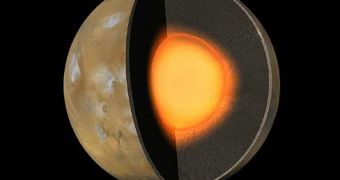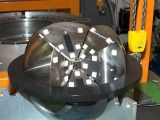Mars' surface is a frozen wasteland composed primarily of basalt and full of craters. Much of the surface is deeply covered by a fine iron(III) oxide dust that has the consistency of talcum powder. The planet has no intrinsic magnetic field, even though parts of the planet's crust have been magnetized.
But hundreds of miles below the surface there's a hot sea of molten iron, nickel and sulfur that forms a liquid core. A recent study shows that this molten sea will eventually cool down and solidify, either from the outside-in, forming an iron-nickel core, or from the inside out, forming a core of a fool's-gold-like minerals.
Andrew Stewart is a planetary geochemist at the Swiss Federal Institute of Technology and co-author of the study: "If liquid metal moves around a solid core, it could create a natural dynamo like the one found in Earth's core," he said.
If the conditions are right, a liquid can turn into a solid, depending on the temperature, changing its density and even purity. For instance, dry ice - carbon dioxide in its solid state - forms under immense pressure. But if any impurities are added to this ice, its freezing point is lowered.
The same thing happens on Mars, where sulfur mixes things up under the crushing pressure of 5.8 million pounds per square inch, which is 400 times the atmospheric pressure at the surface of the Earth.
The team simulated the pressure conditions on Mars using a diamond-making machine where they subjected samples with different portions of sulfur to huge pressures, like those required to form diamonds.
What they found is a true possibility for Mars' core to solidify in the not so near future, when a low amount of sulfur would cause nickel and iron to solidify in chunks in the space near the outer edge of the core, which would sink to the center.
For a more accurate prediction, Stewart will have to wait for the ExoMars mission, that will reach Mars in 2013, deploying a surface probe called NetLander, designed to listen for Martian earthquakes.
"Once we have seismic data from Mars, we'll be able to know the sulfur content and what's going to happen to Mars' core."

 14 DAY TRIAL //
14 DAY TRIAL // 
